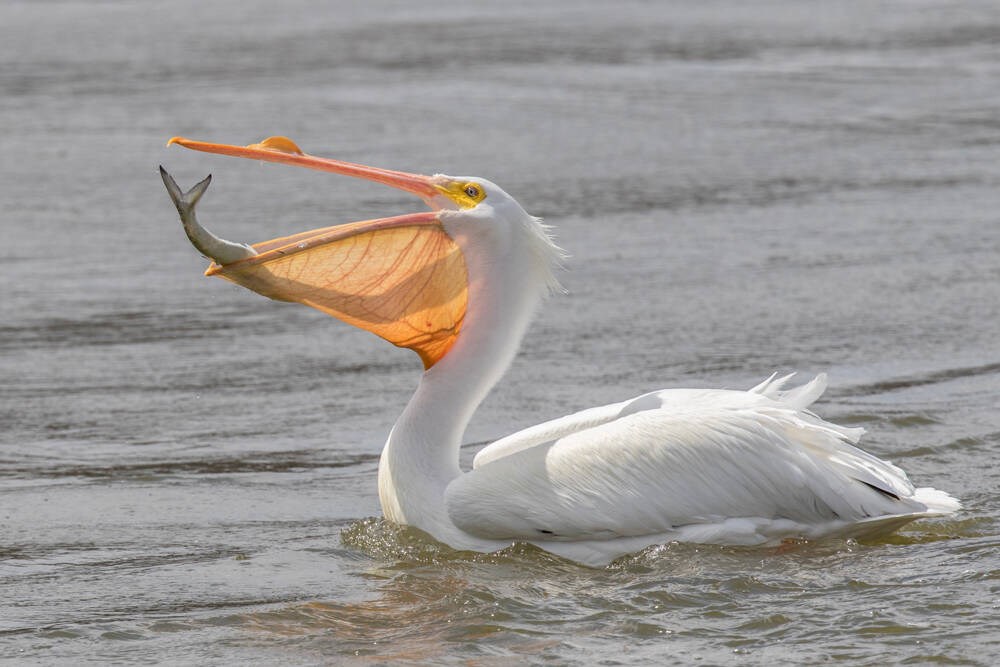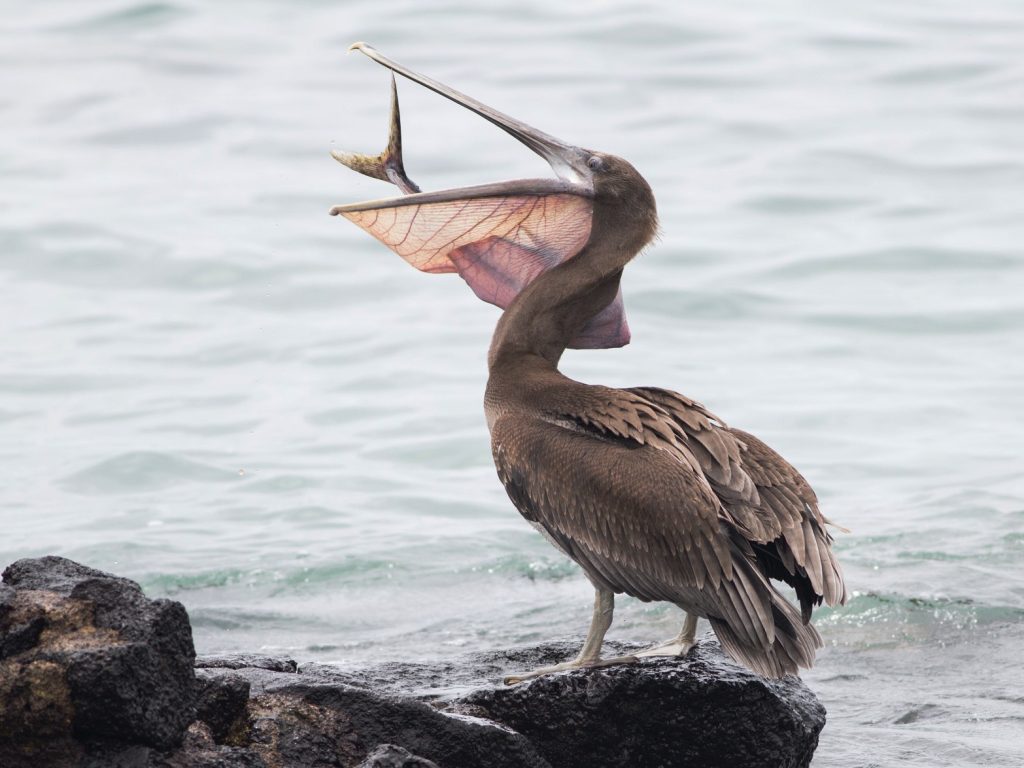In Vermont, both the American White Pelican and Brown Pelican, which are two pelican species found in North America, can occasionally be spotted, although they are not commonly seen.
Pelicans, known for their massive bills, throat pouches, and feet, are among the largest birds in the world. Despite their size, they possess lightness due to air pockets within their skeleton and skin, aiding in buoyancy, while their elongated wings enable them to soar gracefully through the air.
The world is home to eight distinct pelican species, two of which reside in North America—the American White Pelican and the Brown Pelicans.
During the breeding season, pelicans undergo notable transformations, as their facial skin, throats, and bills become adorned with vibrant colors, while some develop additional structures on their bills.
Pelicans engage in colony breeding, with groups comprising up to 50,000 birds. Depending on the species, these colonies may choose either ground or tree nests. After approximately 25 days in the nest, the young pelicans assemble in “creches” consisting of up to 100 individuals, and remarkably, parents can identify and exclusively feed their own chicks.
While pelicans are predatory birds, they are not classified as birds of prey, which exclusively includes raptors. Their diet primarily consists of fish, although they also consume crabs, frogs, snakes, mammals, birds, and insects.
Using their expandable throat pouches, pelicans adeptly capture fish, draining the water before swallowing. Additionally, young pelicans directly feed from their parents’ pouches.
To assist in identifying the pelican species observed in Vermont, this guide draws on avibase and incorporates data gathered from bird watchers on ebird to provide factual information regarding the timing of these bird sightings.
2 Pelican Species in Vermont:
American White Pelican

Although American White Pelicans are infrequent visitors to Vermont, occasionally observed during migration, there have been a couple of recorded sightings. In 2020, they were last seen near Lake Morey and Molly’s Falls Pond State Park.
These large soaring birds, the American White Pelicans, possess the second-largest average wingspan among North American avians.
Non-breeding adult American White Pelicans exhibit a predominantly white plumage, save for black flight feathers visible during flight or when the wings are spread. They boast bluish-gray eyes and yellow facial skin encircling their eyes. Their bills, pouches, and feet exhibit a pale orange hue. Juveniles display light gray feathers with darker brown napes.
During the breeding season, adult American White Pelicans display distinct coloration from their non-breeding counterparts. They develop a yellow plate resembling a horn on their upper bills. While their bodies remain entirely white, their eye area, bills, legs, and feet become a brighter shade of orange.
American White Pelicans experience molting changes, known as “eclipse.” In spring, a visible yellowish patch emerges on their breast and chest, while blackish feathers appear on their heads during summer.
- Pelecanus erythrorhynchos
- Length: 60 – 63 inches (152 – 160 cm)
- Weight: 246.4 ounces (6983 g)
- Wingspan: 96 – 110 inches (244 – 279 cm)
American White Pelicans breed in secluded inland lakes within North America before spending the winter along the southern Pacific Coast of the United States, the Gulf of Mexico, Mexico, and Central America. During migration, they can be sighted in western and central states of the US.
These pelicans inhabit shallow freshwater lakes, wetlands, and the perimeters of lakes and rivers. In winter, they can be found in coastal bays, inlets, and estuaries, where they foragein shallow waters and rest on sandbars.
Fish constitute the primary diet of American White Pelicans. They glide on the water’s surface, capturing their prey with their expansive bills. Additionally, they engage in cooperative foraging with other birds, employing coordinated tactics to corral fish towards the shoreline, facilitating efficient feeding.
These opportunistic feeders will travel considerable distances in search of more abundant feeding grounds. They may also consume crayfish, amphibians, and salamanders. Interestingly, they are known to pilfer fish from other birds floating on the water’s surface.
American White Pelican vocalizations are typically limited to silence or occasional grunts, while the young may emit noisy calls within the large colonies to request food.
Nests of American White Pelicans are relatively basic, shallow depressions on the ground. Twigs, sticks, reeds, and various materials are added atop the soil for protection of the eggs.
The female pelican then lays one to two eggs, which both parents diligently incubate for up to thirty-six days. Unfortunately, due to siblicide, only one chick survives per nest, as one sibling kills the other.
Fun Facts: The American White Pelican possesses a long, enormous bill capable of holding three gallons of water. When catching fish from the sea, the pelican tilts its bill downward to drain the water, enabling it to swallow the remaining fish within its throat sac.
Brown Pelican

Brown Pelicans are exceedingly rare in Vermont, with only a handful of sightings recorded within the state. They are classified as accidental species, and the most recent observations were reported near Lake Dunmore in 2014.
Non-breeding adult Brown Pelicans typically exhibit white heads and necks, accompanied by pale yellow foreheads. Their long bills display a combination of yellow and orange hues. Grayish-brown bodies, short black legs, and webbed feet complete their appearance. Juveniles possess brown heads, necks, backs, and wings, along with bluish-gray bills. Their underside is light brown.
The Brown Pelican encompasses five subspecies, two of which breed within the United States: P.o.californicus, found along the Pacific Coast, and P.o.carolinensis, inhabiting the Atlantic Coast.
Distinct differences between the Pacific and Atlantic Brown Pelicans become more apparent during the breeding season. Both species display white heads with brighter yellow foreheads. However, their napes undergo a color transformation, turning from white to dark brown. Atlantic Brown Pelicans possess olive-brown throat pouches, while Pacific Brown Pelicans exhibit red skin within their throat pouches.
- Pelecanus occidentalis
- Length: 48 – 50 inches (122 – 127 cm)
- Weight: 131.2 ounces (3718 g)
- Wingspan: 78 – 84 inches (198 – 213 cm)
Brown Pelicans either breed and migrate or remain year-round along the Pacific and Atlantic Coasts of North America, extending to northern South America.
These pelicans primarily inhabit shallow water environments, residing throughout the year in estuaries and coastal marine habitats. Resting periods occur on mangrove islets, sandbars, breakwaters, and offshore rocks.
Brown Pelicans possess a remarkable foraging ability that sets them apart. They can plunge into deep ocean waters to capture prey within their throat pouches. Upon resurfacing, the water drains from their pouches, enabling immediate consumption of the catch.
Their diet primarily consists of fish, such as sardines and herring. When not diving, they casually swim and seize prey with their bills. Additionally, they may consume crustaceans, amphibians, eggs, and other young birds.
Brown Pelicans are generally silent, with adults rarely vocalizing except for occasional grunts. Juveniles, however, emit squawking sounds to solicit food.
Nests of Brown Pelicans are typically constructed on the ground rather than in trees. These nests are commonly concealed and protected on islands, within mangroves, or on cliffs. The female takes the lead in nest-building, utilizing reeds, leaves, pebbles, sticks, and soil. Subsequently, she lays two to four eggs, which both parents incubate for approximately a month.
Fun Fact: Brown Pelicans employ their webbed feet to cover their eggs during incubation. However, this practice once posed a threat to the species due to the effects of the pesticide DDT, which caused eggshell thinning, resulting in breakage under the weight of the parents’ feet. Extensive conservation efforts were required to restore Brown Pelican populations.